Is Bigfoot Real?

Image/Photo Copyright: Barnes and Noble
Is Bigfoot Real?
Article By: Angela Shiflett
Is Bigfoot real? This question has been contemplated by cryptozoology enthusiasts, paleontologists, historians, scientists, field researchers, anthropologists, and those with an avid interest in the strange and unusual, the mysterious, and the supernatural. While many have claimed to have obtained Bigfoot evidence and have even expressed the fact that they have personally witnessed a real Bigfoot, the fact of the matter is, Bigfoot is still considered to be a cryptid. Is bigfoot real? You will have to continue reading and decide for yourself.
What is a Cryptid?
A cryptid is a mysterious creature that many believe exists, but that science has yet to acknowledge in an official manner. Cryptozoology is a type of pseudoscience that studies and searches for various types of animals – especially those that are considered to be legendary, mythical, and mysterious – in order to determine whether or not there is a possibility that they exist. To date, Bigfoot evidence has fallen short in establishing the answer to the question, is Bigfoot real? However, the story associated with this cryptid continues to excite, entice, and engage. In this guide, you will be introduced to this lengthy and widely-popular legend.
The Starting Point of the Bigfoot Legend
The official starting point of the Bigfoot legend occurred on August 27th in the year of 1958. It was on that day that Jerry Crew - a bulldozer operator - claimed that he discovered extremely large footprints that appeared to be man-like near Bluff Creek, which was situated nearly 300 miles north of the City of San Francisco in California. News of this supposed Bigfoot evidence quickly spread and was published in the Humboldt Times on October 5th of the same year. It was in this publication that the term “Bigfoot” was officially recorded for the first time. Prior to this, if Jerry Crews had been asked, is Bigfoot real? He would have said "no"; however, he was a solid believer after his experience.
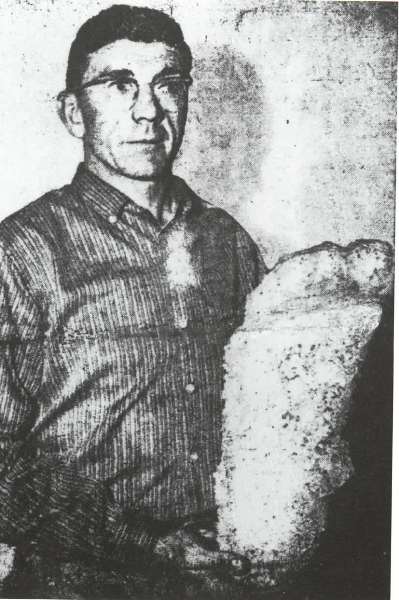
Jerry Crews and the Cast of the Bigfoot Footprint He Observed Near Bluff Creek
Is Bigfoot real? If so, imagine its sheer size based on that footprint cast!
Ray Wallace and The Innocent Prank to Startle Coworkers
Ray Wallace was Jerry Crew’s coworker in the logging camp in Bluff Creek. A friend had given Wallace a 16-inch alder wood carved model of a human foot. Wallace took that model and left tracks around the logging gear in order to play a prank in which he worked. He was not expecting the situation to explode like it did, but being a prankster that enjoyed having a little fun, he continued to play right into it by reporting Bigfoot sightings, saying he heard unusual sounds like were likely coming from the creature, and claiming to have witnessed other types of Bigfoot evidence. Is Bigfoot real? In this case, Mr. Wallace made him real to many people.
According to his son – who admitted that the entire thing was a prank after his death in the year of 2002 – Ray Wallace, “…was a prankster, but never malicious.” He continued by explaining that he just had a high level of enthusiasm for playing jokes. For Bigfoot enthusiasts, admitting that the logging camp’s Bigfoot evidence was a prank did not come as much of a surprise; however, Wallace’s family has confirmed that there does seem to be a lot of evidence that suggests that Bigfoot is, indeed, real.
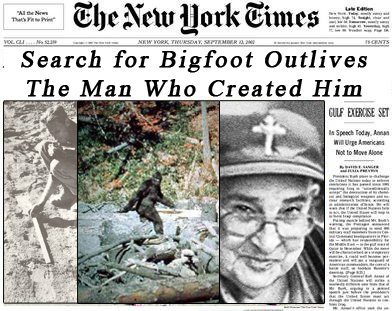
Copyright: The New York Times
Is Bigfoot real? Yes, in the minds of those that were subjected to Raymond Wallace's humor.
The Gimlin and Patterson Bigfoot Film
The Gimlin and Patterson Bigfoot Film was shot in the year of 1967, alongside the famous Bluff Creek where Jerry Crew originally observed massive human-like footprints in the mud. It featured a subject – which is - to date - considered to be unidentified – that the creators claimed was the real Bigfoot. The individuals that shot the film was Roger Patterson and Robert “Bob” Gimlin. According to the creators of the film, it was shot on the 20th of October in 1967.
While several decades have passed, it was this film that actually turned Bigfoot into a household name. The footage that was obtained in this film and the stories surrounding it still result in a tremendous amount of fascination among both believers and non-believers. The men that created it formerly worked in the rodeo in Yakima County, which is located in Washington. They had a passion for the great outdoors, but were extremely enticed by the mysterious Bigfoot creature supposedly roaming in the wild.
While the footage of Bigfoot lasts for less than a minute, the image portrayed in frame # 352 is now considered to be the universal symbol of the mysterious creature. According to those that have seen the Gimlin Patterson Bigfoot Film, the large ape in the footage is a female who has been named “Patty”. Despite over fifty years in film and costume technology, this Bigfoot movie has yet to be debunked by professionals, despite many believing it is a hoax.
In fact, this film has fueled the fire of those that believe in Bigfoot. A professor of anthropology and anatomy that works at Idaho State University – Dr. Jeff Meldrum - openly studies Bigfoot and all things related. He believes that the film is legitimate. He has gone on to say that it is easy for many to believe that the film shows a man in a suit; that is, “…until you see it up against a man in a fur suit…”
When the professor shows the Gimlin Patterson Film of Bigfoot to his studies in anatomy, he asks them to point out any type of surface anatomy features that they observe. He has documented the fact that they all see the trapezius, the deltoid, the movement of shoulder blades underneath the skin’s surface, and the contraction of the quads. None of these features are observed in costumes.
Speaking of costumes, let’s expound on that which Phillip Morris – a popular costume manufacturer – claimed prior to passing away in the early 2000s. He reported that he sold the gorilla suit seen in the film to Roger Patterson. Despite this claim, no evidence of the transaction has been provided to confirm that it actually occurred. To further the debate over the legitimacy of the film, another man by the name of Bob Hieronimus claimed that he was the man in the suit on the film. This has yet to be proven.
Professor Meldrum has clearly stated, “No, I don’t BELIEVE in Bigfoot. “‘Belief’ …connotes a position of faith, a conviction held in the ABSENCE of evidence…. I, for one, am CONVINCED by the evidence I have studied at length.” In other words, he does not BELIEVE in the existence of Bigfoot, he is convinced that the creature is, in fact, real. Dr. Meldrum is the author of the book titled, Sasquatch: Legend Meets Science.
Analyzing the Gimlin-Patterson Bigfoot Footprints
Cliff Barackman – best known for his role as the co-host on the Animal Planet show Finding Bigfoot – has researched Bigfoot for over twenty years. To date, he possesses one of the absolute largest footprint collections of the world. In his studies on the mysterious creature, he has observed a lot of fake prints; however, he claims that those obtained from Gimlin and Patterson cannot be easily dismissed.
He claims that the way the creature has a trailing leg displays a high level of foot flexibility. In the Gimlin Patterson Bigfoot Film, the animal lifts the heel, but keeps the front section of the foot in constant contact with the ground. One of the prints displays a highly distinct ridge of pressure. This is only possible when there is a high level of flexibility in the middle of the foot. As a result of these unique characteristics, it is exceptionally difficult to deny that the creature is real.
Bigfoot Interest at an All-Time High
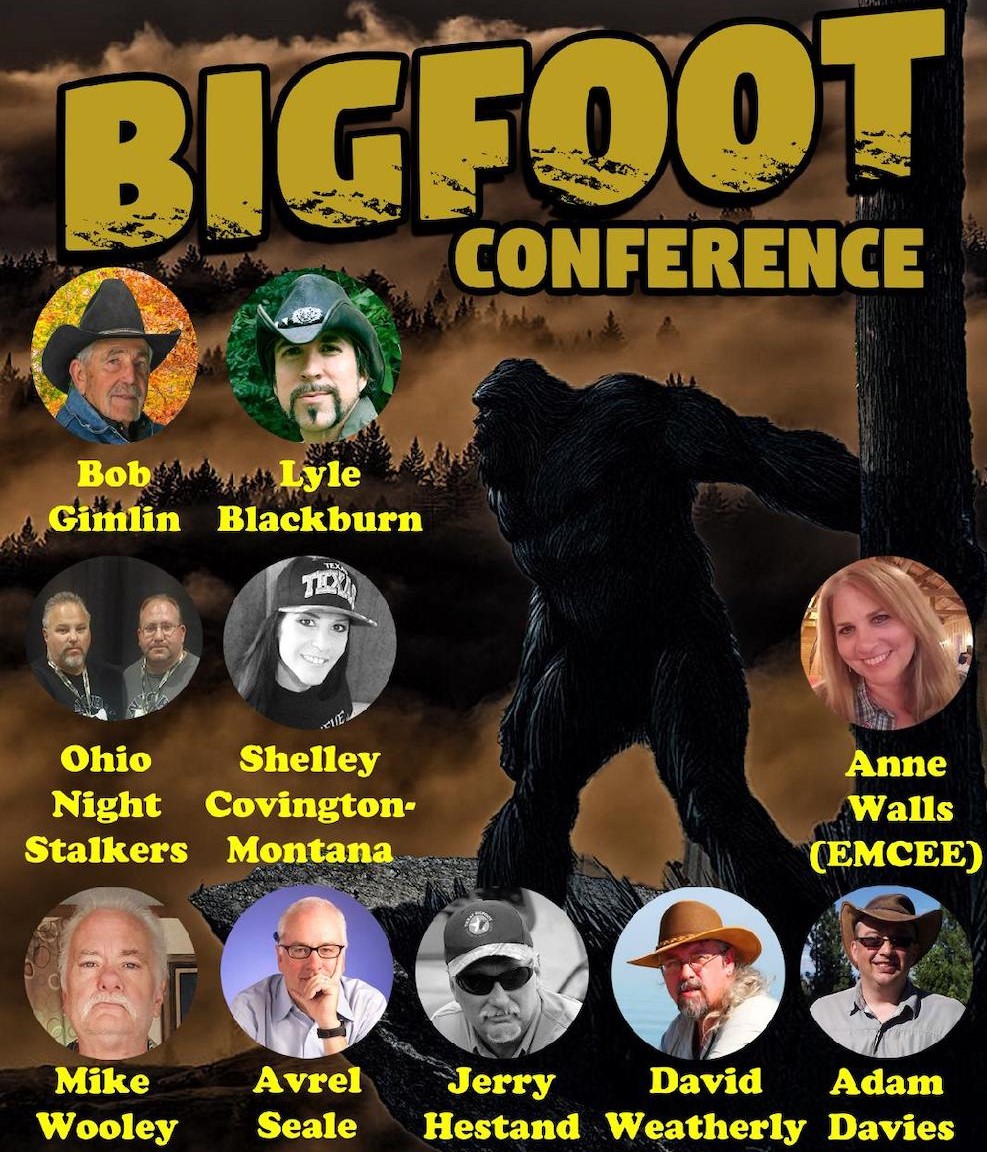
Flier Image from the 2019, 2nd Annual Bigfoot Conference in Southwest Texas
Is Bigfoot real? Those that attend these conferences do believe in his existence.
Despite the fact that Ray Wallace’s adult children confirmed the Bigfoot evidence in Bluff Creek was all just a prank, people continue to believe in the legendary creature. All throughout the United States, there are various conferences, museums, and other attractions that directly pertain to Bigfoot and those that answer “yes” to the question, "Is Bigfoot real?" Examples of these include the following:
· The Annual Bigfoot Conference in Texas Hosted by the North American Wood Ape Conservancy
· The Annual Sasquatch Summit in Washington State
· The Smoky Mountain Bigfoot Conference
· The Honobia Bigfoot Conference & Festival
· Cryptid Con – Bigfoot, Monsters & Legends
· The Bigfoot Discovery Museum
· North American Bigfoot Center
· The Roanoke Island Bigfoot Museum
· The Surreal Bigfoot Sculpture
·
The Bigfoot Imprint at the Museum of the
Bizarre
A Long History of Bigfoot Sightings
The legend of Bigfoot goes back hundreds of years; however, these legends actually predate the official “Bigfoot” identification. It is a known fact that most of the cultures have had their own accounts of giants that are incredibly “human-like” throughout their folk-based history. The name given to the creature was based on the specific culture, the language spoken by that culture, and the region in which the people of the culture resided. If you were to ask many people of these historical cultures, “Is Bigfoot real?”, they would answer “yes”. Examples of names given to Bigfoot throughout history include the following:
· Wild Man
· Hairy Man
· Ts’emekwes
· Stiyaha
· Kwi-kwiyai
· Skoocooms
· Sasquatch
· Yeti
· The Abominable Snowman
· Gigantopithecus
· Skunk Ape
· Yowie
· The Almas
· The Grassman
· Wendigo
· Orang Pendek
· Mapinguari
· Yeren
There are various areas – particularly within the United States – that have unique names for Bigfoot, based on the location where sightings and/or encounters have occurred - in addition to those named above. Is Bigfoot real? If you asked those in the areas listed below, they would definitely agree to the fact that the elusive creature seems to exist. Examples include the following:
· The “Bardin Booger” in Bardin, which is located in Putnam County, Florida
· The “Minerva Monster” in Minerva, which is located in the counties of Carroll, Columbiana, and Stark in the State of Ohio
· The “Fouke Monster” or “Boggy Creek Monster” in Fouke, which is located in Miller County, Arkansas
· “Momo the Monster” originally reported in Louisiana, Missouri and has since been reported in various other areas of the state
· The “Honey Island Swamp Monster” in Honey Island Swamp, which is located in the eastern region of the State of Louisiana in an area referred to as St. Tammany Parish.
Scientific Perspective on the Existence of Bigfoot
Scientists have pondered the question, “Is Bigfoot real”, for several decades; however, very few formal studies have been conducted to answer that question. To date, no fossil records are available regarding the presence of great apes located in the United States. Additionally, no known remains have been located that indicate the existence of this legendary creature. Is Bigfoot real when it comes to scientists? For some, yes; however, for science as a whole, no.
In the year of 1973, a book by John Napier was released called, Bigfoot: The Yeti and Sasquatch in Myth and Reality. The information contained therein is said to be the first of the scientific-based studies of presumed Bigfoot evidence. At the time, Napier concluded that there was not enough evidence to suggest the reality that the creature exists; however, he did express the fact that it was hard to reject all of prints that had been previously discovered, the massive amount of sightings, and the direct encounters recalled by vast numbers of people.
In addition to Napier’s work, the following scientific studies were conducted to determine the answer to the question, "Is Bigfoot real?"
· The National Wildlife Federation provided funding in the year of 1974 to uncover Bigfoot evidence; however, no distinctive discoveries were made.
· Anthropologists George Agogino, Grover Krantz, William Charles Osman Hill, and Carelton Coon researched Bigfoot, yet reached no conclusions.
· Grover Krantz published numerous articles and several statements of book length on the topic, but much of the evidence he outlined were later deemed to be hoaxes.
· The University of Oxford conducted a study that started in the year of 2012 and lasted three years that analyzed various types of hair samples. Did they determine is Bigfoot real? No, they have concluded that Bigfoot does not exist – to date.
· In 2009, a study by J.D Lozier was published in the Journal of Biogeography that outlined the ecological preferences of Bigfoot. It was established that – based on sightings of the supposed creature – the ecological preferences were the same of the American black bear. As a result of this conclusion, research indicated that the sightings that had occurred were probably upright and/or large black bears and not the legendary Bigfoot.
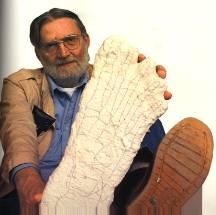
Grover Krantz, Anthropologist, Author, and Believer in Bigfoot
The FBI Bigfoot Inquiry File
You may be surprised to know that the Federal Bureau of Investigation actually created a file on the legendary Bigfoot in the year 1976. On June 5th 2019, that 43-year old file was officially released to the public. The starting point for this massive file was when the Director of the Bigfoot Information Center and Exhibition – Peter Byrne – mailed 15 hairs attached to a small section of what appeared to be skin to the FBI. The goal? He wanted the hairs analyzed so that he could answer the question, "Is Bigfoot real?". He also inquired as to whether the FBI had made any other Bigfoot-related analyzations and if they had reached any conclusions on the existence of the creature.
At the time, Peter Byrne was considered to be a highly prominent researcher on the Bigfoot subject. The 1970s has often been deemed the height of the Bigfoot craze. This FBI inquiry was sent after the creation and release of the Gimlin-Patterson Bigfoot Film. While later to be revealed as a prank by the good-natured Ray Wallace and the suspicion that the video included an actor in a costume, Peter Byrne always believed that the Bigfoot in the footage was real.
Byrne received a response from Jay Cochran, Jr., who served as the Assistant Director of the Scientific and Technical Services Department with the FBI. In this response, he explained that he could not locate any previous suspicions with the organization on the subject of Bigfoot hair. He continued by explaining that the bureau usually only focused on evidence pertaining to criminal-based investigations. However, there are exceptions for scientific inquiries and research and that he would extend that exception in the case.
Upon researching the hair, Cochran established that it did not belong to the Bigfoot creature. It was in the year of 1977 Cochran returned the hair and his conclusion that the hairs belonged to a deer. In 2019, the government officially declassified the Bigfoot file regarding this 1976/1977 study. Essentially, the FBI helped out this Bigfoot researcher, but they did not endorse the existence of the creature. Ironically, when the files were declassified in 2019, the then 93-year old Byrne never recalled receiving the response concluding the hairs were from a deer. Coincidence or something more? As with all things related to Bigfoot, this is definitely a mystery.

Letter from Jay Cochran, Jr. (FBI) to Peter Byrne Regarding Exception for 15-Hair Analysis
The Todd Standing Bigfoot Documentary
Discovering Bigfoot is a film documentary created by Todd Standing that features direct interactions between Bigfoot creatures and humans - such as wilderness experts, PhDs, and others that specialize in the research of the evasive creature. Is Bigfoot real? In this film, Todd Standing presents never released footage and images of Bigfoot creatures that are incredibly detailed and help lend to the credibility of the existence of the creatures. For the believer, this is an amazing documentary with incredible Bigfoot evidence, but like every attempt to establish that this cryptid truly does exist, many believe that Todd Standing is a hoaxer.
If that is the case, why did he sue the provincial government in British Columbia to prove that the creature exists? He simply wanted a judge to declare that the creature is real and for a wildlife official to get with him and go on a three-month search for the evasive creatures. Despite his desire for the Washington, Alberta, and BC Departs of Fish and Wildlife to recognize Bigfoot and to do a wildlife management report associated with the species, the case was thrown out of court. For believers, though, eyes should remain on Todd Standing and his further research as he seems to be well on his way to providing the existence of Bigfoot.
The Bigfoot Field Researchers Organization
Today, the largest (and oldest) organization with a focus on the scientific research of the many aspects associated with the Bigfoot phenomenon is the Bigfoot Field Researchers Organization (BFRO). Since the year 1995, this organization – which consists of a community that includes specialists, scientists, and journalists – have engaged in a multitude of projects designed to provide a definitive answer to the question, “Is Bigfoot real?”. These include laboratory research projects as well as field investigations.
The educational backgrounds, experience, and the efforts put forth by the members of this organization has resulted in the Bigfoot Field Researchers Organization being recognized as the most credible and widely respected network of its type. In every study, the BFRO seeks to gather Bigfoot evidence that will conclude that the creature is, in fact, real. Its website includes a reporting form that individuals may use to report any type of sighting and/or encounter with a real Bigfoot. In most instances, the researchers will follow up on the incident – either by phone, email, or in person.
The Bigfoot Field Researchers Organization seeks to have scientists recognize Bigfoot as a real creature so that governmental-based land agencies will acknowledge their existence when creating the management of certain regions. By ensuring official documentation, the species will be protected. The organization believes that Bigfoot is a rare and possibly even an endangered species that should have the highest level of protection – in terms of their habitat and their lives.
Is Bigfoot real? According to those that avidly research and meet with those that have claimed to have seen or experienced him, the answer is yes. Have you seen the creature? Have you had a direct encounter? Submit an official report by clicking the link below:
Make an Official Report Regarding a Bigfoot Sighting Here
Where Is Bigfoot and Which States Have the Highest Level of Sightings?
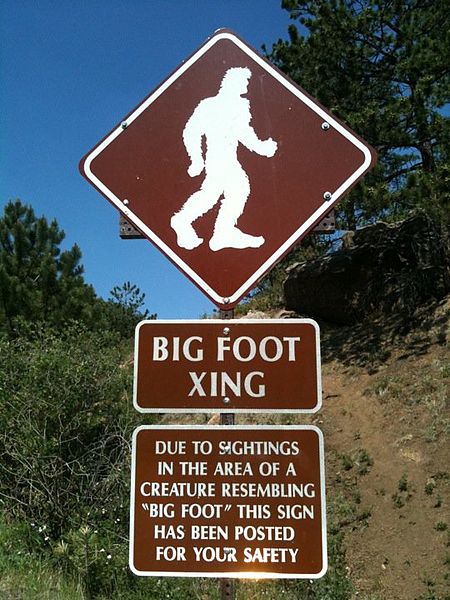
Big Foot Crossing Sign Located in Colorado Springs, Colorado at Pikes Peak Highway
Bigfoot sightings are most commonly reported in the Pacific Northwest. This area includes British Columbia, Oregon, Washington, and Idaho. Additional sighting locations in this region include Southeastern Alaska, the Northern California area, Montana, and Yukon. Just over a third of the total sightings and encounters occur here; however, the remaining sightings and encounters occur throughout all of the rest of the North America region.
There are states with higher concentrations of sightings than others. The Bigfoot Field Researchers Organization recently released information on which states have the highest level of sightings. While the information gathered may vary from year to year, the states with the highest number of reports typically remain about the same - in terms of ranking. Below, you will learn about the top 5 states with the highest reported sightings.
1. Washington
To date, Washington State holds the record for sightings. Coming in at over 2,000 documented reports, this is considered to be the most active region – worldwide – for Bigfoot sightings and encounters. The areas with the highest number of incidents include Okanogan County and the Blue Mountains. Ape Canyon is an area that has a high level of reports, too. In fact, it is also the area where the most aggressive encounter took place.
This happened to a mining group in the year of 1924. It was reported that several Sasquatches surrounded a cabin, throwing rocks and attempting to break in the structure. Additionally, a highly experienced skier disappeared in the area and was never located. There is a native Indian legend that there are many “Ape Men” residing on Mount St. Helens, which is located in close proximity to Ape Canyon.
For the best chance of sighting one of these
mysterious creatures, Washington is the way to go; however, do not travel
alone. Just ask anyone in and around the areas highlighted here, "Is Bigfoot real?", and you will quickly hear all the reasons why you should never attempt to confirm the creature's existence alone.
2. California
The State of California has received nearly 1,700 sightings of Bigfoot. This is the state where it all started in 1958 when Jerry Crews discovered footprints. This is also the state where the Gimlin-Patterson Bigfoot Film was shot and a newspaper originally dubbed the term “Bigfoot” to describe the suspected hairy cryptids in the area. Covered in vast mountains, valleys, and forests, this is an excellent area for the cryptids to hide. Once you complete your search for Bigfoot, you can stop off at one of the many beautiful beaches that are situated along the state.
3. Pennsylvania
With nearly 1,400 documented sightings, the Appalachian range within the gorgeous State of Pennsylvania is a Bigfoot sighting hotspot. Dense forestlands, a multitude of fresh water sources, and massive mountains offer plenty of space for the evasive Bigfoot to go undetected. Top regions for sightings include Clarion County, the I-80 Frontier, the Beech Creek region, Allegheny National Forest, and Elk County. Is Bigfoot real and lurking among the gorgeous woodlands throughout this state? Most would confirm this.
4. Michigan
The State of Michigan has nearly 1,200 documented sightings and counting. The largest amount of these occur in and around the Seney National Wildlife Refuge. The counties that have had the highest level of Bigfoot activity throughout the years includes Allegan, Barry, Ionia, Kent, Muskegon, and Ottawa. Interestingly, many people throughout the state refer to the Bigfoot/Sasquatch as “Shadow People”. When asked "Is Bigfoot real?", most within this state will acknowledge their belief in the mysterious creature.
5. New York
According to all things regarding the Bigfoot legend, Whitehall, New York has earned the name of the “Bigfoot Capital” of the entire east coast. As a result of this, the official town animal is Bigfoot. If you ask any of the residents of this town, "Is Bigfoot real?", you are to get the answer, "yes!".Despite its high population, the State of New York has nearly 1,100 reported Bigfoot sightings.
The most popular sighting occurred in the year of 1976 on Abair Road. It was here that teenagers claimed a large, hairy, unknown creature charged them. Upon retrieving police officers for assistance, the officers also observed the creature. That same night, there was a multitude of sightings. As a result, the occurrence is now referred to as the “Abair Road Incident”.
Is Bigfoot Real? – The Final Analysis
As you can see from the information contained in this comprehensive guide, the answer to the question, “Is Bigfoot real?” is not as simple as a “yes” or a “no”. This stems from the fact that there is no conclusive scientific Bigfoot evidence that establishes the reality of this mysterious cryptid; however, it is difficult to dispute the eyewitness encounters and sightings that have occurred all throughout history.
While the term “Bigfoot” originated in the late 1960s, stories of a humanoid primate-like creature have been told all throughout history – even back to the earliest of civilizations. Many spoke of the “Hairy Man”, while others called the creature the “Wild Man”. There were various names for the creature. While it does not seem too far-fetched that a large primate may be secretly lurking through the forests and mountains of our world, until we have solid evidence of their existence, Bigfoot is only “real” to those that have seen him, encountered him, and believe in the unexplained.
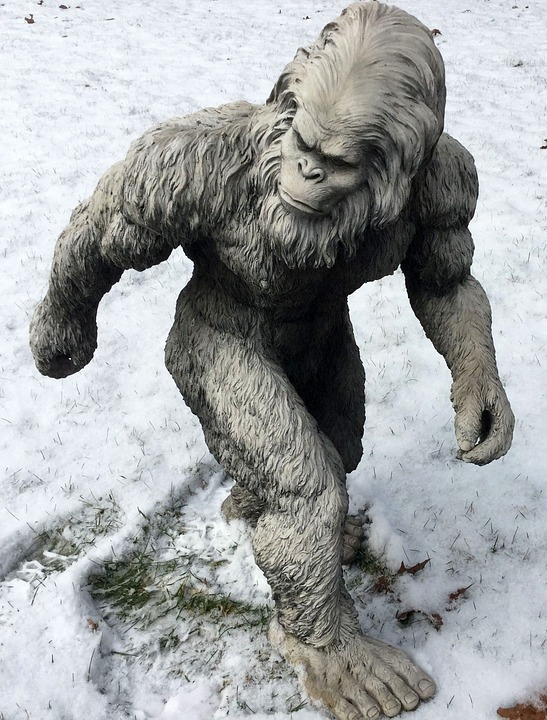
Return to Is Bigfoot Real Top of Page
Return to Greatest Unsolved Mysteries Home Page
Explore the Index of Greatest Unsolved Mysteries
Copyright © 2009-2022 greatest-unsolved-mysteries.com
All Rights Reserved